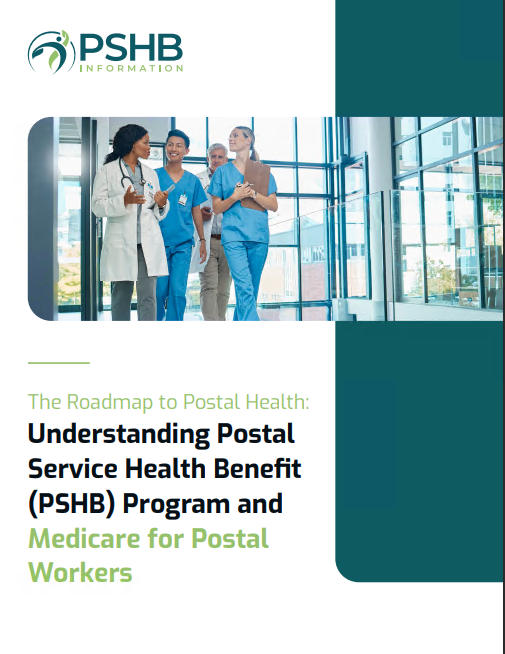Key Takeaways
-
PSHB and Medicare work together to provide health coverage, but knowing who pays first depends on your specific situation.
-
Understanding cost-sharing rules can help you maximize benefits and avoid unexpected out-of-pocket expenses.
How PSHB and Medicare Work Together
If you’re a retiree or employee of the United States Postal Service (USPS), you may be wondering how your Postal Service Health Benefits (PSHB) plan coordinates with Medicare. Since 2025 marks the first year of the PSHB program, understanding how these two forms of coverage interact is essential for avoiding unnecessary costs and ensuring seamless healthcare coverage.
By having both PSHB and Medicare, you gain access to a more comprehensive healthcare plan, but it’s important to know how they work together to avoid unnecessary costs or denied claims. Each program has its own set of rules regarding deductibles, premiums, and cost-sharing, so making informed decisions will help you optimize your benefits.
Who Pays First? The Coordination of Benefits Explained
When you have both PSHB and Medicare, the order in which they pay depends on your specific situation. Coordination of benefits (COB) rules determine who pays first and how much you owe. Knowing these rules can prevent unexpected bills and ensure your claims are processed correctly.
If You’re an Active USPS Employee
-
PSHB is primary: Medicare is secondary if you are still working and covered under a PSHB plan through employment.
-
Medicare pays after PSHB: This means PSHB covers your medical expenses first, and Medicare may cover some of the remaining costs.
-
Prescription drug coverage: Your PSHB plan will typically cover prescriptions, but you can also enroll in Medicare Part D for additional benefits.
If You’re a Retired USPS Employee
-
Medicare is primary: Once you retire and are enrolled in Medicare, it typically becomes your primary payer.
-
PSHB acts as secondary coverage: Your PSHB plan covers some costs that Medicare does not, such as copayments, coinsurance, and deductibles.
-
Prescription drug costs may be lower: Many PSHB plans offer integrated prescription drug benefits through Medicare Part D, helping you save on medication expenses.
If You Have Dependents on Your Plan
-
Dependent rules vary: If your spouse or dependents are on your PSHB plan and they are not enrolled in Medicare, PSHB remains their primary coverage.
-
Medicare-eligible dependents follow the same COB rules: If your spouse is retired and on Medicare, their coverage will follow the primary-secondary structure outlined above.
-
Ensure all dependents are properly enrolled: Failure to coordinate benefits correctly can result in denied claims or higher out-of-pocket costs.
What’s Covered Under PSHB and Medicare?
Medicare Part A (Hospital Insurance)
Covers inpatient hospital stays, skilled nursing facility care, hospice, and some home health services. If you’ve worked at least 10 years (40 quarters), you typically don’t pay a premium for Part A.
Medicare Part B (Medical Insurance)
Covers outpatient care, doctor visits, preventive services, and durable medical equipment. There is a standard monthly premium for Part B in 2025, which is $185.
Medicare Part B also covers medically necessary services like diagnostic tests, outpatient therapy, and mental health services. These costs can add up, making it beneficial to have PSHB as secondary coverage to reduce your out-of-pocket expenses.
PSHB Coverage
PSHB plans provide benefits similar to those previously available under the Federal Employees Health Benefits (FEHB) Program, including:
-
Doctor visits and outpatient care
-
Prescription drugs
-
Preventive screenings and wellness visits
-
Emergency and urgent care
-
Hospitalization and surgeries
-
Vision and dental benefits (in some plans)
-
Specialty care and rehabilitative therapy
How Costs Are Shared Between PSHB and Medicare
Deductibles
-
Medicare has separate deductibles for Part A and Part B.
-
PSHB may cover some or all of these deductibles, depending on your specific plan.
-
Know your plan’s cost-sharing requirements: Some PSHB plans may require a small deductible before covering remaining Medicare costs.
Copayments and Coinsurance
-
Medicare Part A and B have cost-sharing requirements, meaning you are responsible for a portion of your medical costs.
-
PSHB can help lower these costs by covering some copayments and coinsurance.
-
Specialist and hospital visits may have different cost-sharing requirements: It’s important to check both your PSHB and Medicare plan details.
Out-of-Pocket Maximums
-
PSHB has an annual out-of-pocket maximum, protecting you from excessive medical expenses.
-
Medicare does not have an out-of-pocket maximum, so having PSHB as secondary coverage can help limit high costs.
-
Prescription drugs also have cost caps: Medicare Part D includes an annual out-of-pocket cap of $2,000 in 2025.
Prescription Drug Coverage: PSHB vs. Medicare Part D
Medicare Part D (Prescription Drug Plan)
-
Covers prescription drugs, with costs varying based on formulary tiers.
-
Includes an out-of-pocket cap of $2,000 in 2025.
-
Some plans may include enhanced benefits or mail-order discounts.
PSHB Prescription Benefits
-
Many PSHB plans integrate Medicare Part D coverage through Employer Group Waiver Plans (EGWPs), simplifying prescription benefits.
-
Lower drug costs for retirees with Medicare: If you have both PSHB and Medicare, your drug costs may be lower due to coordinated benefits.
-
Review formulary changes annually: Drug coverage may change each year, so it’s important to stay updated on covered medications.
When Should You Enroll in Medicare If You Have PSHB?
If You’re Retired
-
Enroll in Medicare Part A and Part B at age 65 to avoid late penalties.
-
If you delay enrollment in Part B and do not have active employment-based coverage, you may face penalties and gaps in coverage.
If You’re Still Working
-
You can delay Medicare Part B enrollment without penalty if you’re actively employed and covered under a PSHB plan.
-
Once you retire, you should sign up for Part B immediately to ensure continued coverage.
-
Check employer verification requirements: Some documentation may be needed to confirm that you had creditable coverage before enrolling in Medicare Part B.
Making the Most of Your Coverage
Having both PSHB and Medicare in 2025 offers a strong combination of health benefits, but understanding the coordination of payments is key to making informed healthcare decisions. Whether you are newly retired or still working, knowing how these plans interact ensures that you avoid coverage gaps and maximize cost savings. If you have questions about your coverage options, speak with a licensed agent listed on this website to get personalized guidance.








